
The plank is one of the best exercises to strengthen your core, which is more than just your abdominals. The core is a complex series of muscles that includes your entire body, minus your legs, head and arms.
Various plank exercises challenge all the major muscle groups and stabilizers, improve strength, and prevent injury. The plank is 100 percent excuse free, meaning no equipment, machines or special apparel are required. All you need is a little motivation, direction and structure to reach your goal.
Tighten your torso, flatten your abs, and improve your strength with the 30-day plank challenge.
The 30-Day Plank Challenge
Every day for 30 days you will time yourself as you hold a plank and side plank. You will progress through various levels of intensity to challenge your body as it develops strength and muscular endurance. Here are your options:
Regular Plank Tiers
- Level 1: Static Knee Forearm Plank
- Level 2: Static Forearm Plank
- Level 3: Static Single-Leg Forearm Plank
- Level 4: Dynamic Elbow to Wrist Plank
Side Plank Tiers
- Level 1: Static Knee Side Forearm Plank
- Level 2: Static Low Side Forearm Plank
- Level 3: Static Single-Leg Side Forearm Plank
- Level 4: Dynamic Side Forearm Plank With Hip Dip
How The 30-Day Plank Challenge Works
- On day one, you start with the level that works best for you. Hold the plank for as long as you can maintain good form. This will be your benchmark time.
- Each day thereafter, you simply hold the plank longer. A great goal is to hold it for 5 to 10 seconds longer than the day before. When you reach 90 seconds, and your form is still perfect, then it's time to advance to the next level of the challenge.
- Once you reach level four, simply focus on moving through the dynamic moves for as long as you can. Focus on the endurance of the exercise to keep your body challenged.
- Record your level and your times on your daily tracker so you can easily measure and review your progress.
Remember, some days are better than others. Don't be discouraged if some days are harder, focus on the overall trend. This is why your tracker is so important to use during this challenge. Once you see how you've moved up levels and improved your times over the weeks, you will be amazed by how strong you feel.
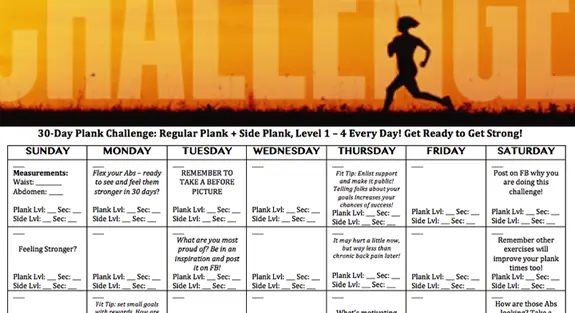
Getting Started
- Finish this post for proper form and injury prevention tips.
- Pick a start date and write it down in your calendar.
- Enlist support. Forward this challenge to a friend. It makes it easier to stick to your goal.
- Get your tracker by signing up online.
- Get social for more support and motivation. Like the 30-Day Challenge Series on FaceBook and/or Follow @skinnytinis on Twitter.
Regular Planks
Level 1 - Static Knee Forearm Plank
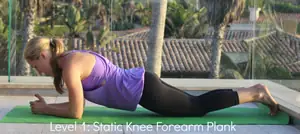
Start with your knees together and on the ground. Place your elbows directly under your shoulders and rest your weight on your forearms. Flatten your spine, and press through your elbows to keep your chest from falling forward. Suck your navel into your spine and tighten your abdominals. Look straight down, allowing your neck to stay aligned with your spine.
Level 2 - Static Forearm Plank
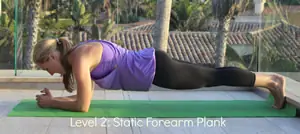
Level 3 – Static Single-Leg Forearm Plank
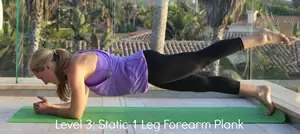
Start with your toes together and on the ground. Place your elbows directly under your shoulders and rest your weight on your forearms. Flatten your spine, and press through your elbows to keep your chest from falling forward. Suck your navel into your spine and tighten your abdominals. Look straight down, allowing your neck to stay aligned with your spine. Lift one leg off the ground to challenge your stability. Be sure to alternate legs. Once you reach one minute on each leg with little struggle, then progress to level four.
Level 4 - Dynamic Elbow to Wrist Plank
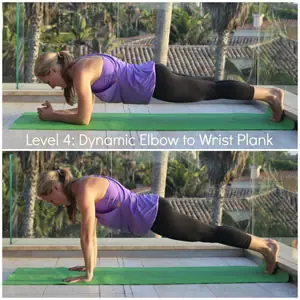
Start in a high plank and move into low plank. Repeat for as long as you can.
More: The Benefits of Functional Core Training
Side Planks
Level 1 - Static Knee Forearm Side Plank
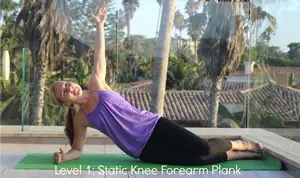
Start with your knees together and on the ground. Place your right elbow on the ground directly under your shoulder. Straighten your spine, tighten your abdominals, and look straight ahead. Hold. Repeat on the left side. Once you reach one minute on each side with little struggle, then progress to the next level.
Level 2 - Static Low-Side Forearm Plank
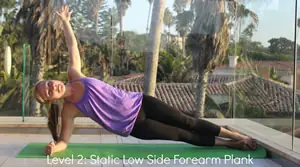
Start with your feet together and on the ground, keep your knees lifted and the body in one straight line. Place your right elbow on the ground directly under your shoulder. Straighten your spine, tighten your abdominals, and look straight ahead. Hold. Repeat on the left side. Once you reach one minute on each side with little struggle, then progress to the next level.
Level 3 - Static Single-Leg Side Plank
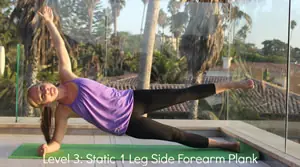
Start with your feet together and on the ground, keep your knees lifted and the body in one straight line. Place your right elbow on the ground directly under your shoulder. Lift your left leg 6 inches off the other leg. Straighten your spine, tighten your abdominals, and look straight ahead. Hold. Repeat on the left side. Once you reach one minute on each side with little struggle, then progress to the next level.
Level 4 - Dynamic Side-Forearm Plank With Hip Dip
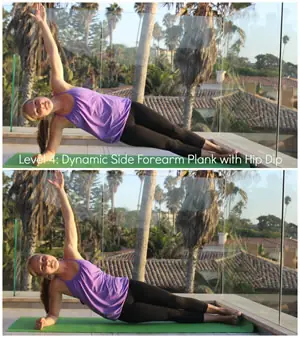
Start in a low side plank (Level 2). Once you're in the right form, begin to dip your right hip toward the ground, and then return to the starting position. Repeat on the left side.
Injury Prevention Tips
- It's recommended to start at level one and progress daily to ensure proper strength and form.
- It's essential that your spine stays level and that you activate your lower abs to protect your low back. If your back starts to arch, or your butt starts to dip, it's time to call it a day.
- Always make sure your wrists or elbows are directly under your shoulders to relieve any shoulder pressure.
- You should not feel any joint, back or shoulder pain during your planks. If you are, it's probably related to your form. Have someone take a picture of you, or ask a personal trainer to review your form. Make sure everything is in a straight line.
- Remember to breath. Holding your breath makes the exercise harder and can cause an increase in your blood pressure. Focusing on your breath can actually improve your concentration and duration.
Download and print these moves to take with you wherever you go.
More: Your 30-Day Ab Challenge
More: Your 30-Day Lunge Challenge
More: 5 Reasons to Strengthen Your Core
More: 30-Day Challenge: Move a Mile a DayMore: Master the Plank
More: Why is a Strong Core Important?
 See more fitness training tips or find an exercise class.
See more fitness training tips or find an exercise class.



